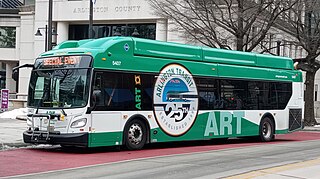
The Tri-County Metropolitan Transportation District of Oregon (TriMet) is a transit agency that serves most of the Oregon part of the Portland metropolitan area. Created in 1969 by the Oregon legislature, the district replaced five private bus companies that operated in the three counties: Multnomah, Washington, and Clackamas. TriMet began operating a light rail system, MAX, in 1986, which has since been expanded to five lines that now cover 59.7 miles (96.1 km). It also operates the WES Commuter Rail line since 2009. It also provides the operators and maintenance personnel for the city of Portland-owned Portland Streetcar system. In 2023, the system had a ridership of 62,055,600, or about 208,900 per weekday as of the second quarter of 2024.

Hillsborough Area Regional Transit provides public transportation for Hillsborough County, Florida. The agency operates fixed-route local and express bus service, paratransit service, demand-response service, MetroRapid service, and the TECO Line Streetcar system. In 2023, the system had a ridership of 12,929,700.

The Edmonton Transit Service (ETS) is the public transit service owned and operated by the City of Edmonton in Alberta, Canada. It operates Edmonton's bus and light rail systems. In 2023, the system had a ridership of 87,646,600, or about 323,800 per weekday as of the second quarter of 2024.

Kenosha Area Transit is a city-owned public transportation agency based in Kenosha, Wisconsin.

Green Bay Metro is the mass transit system found in the city of Green Bay, Wisconsin. It also provides service in Ashwaubenon, Allouez, De Pere, and Bellevue. In 2023, the system had a ridership of 832,900, or about 3,100 per weekday as of the second quarter of 2024.

Ride On is the primary public transportation system in Montgomery County, Maryland. Managed by the Montgomery County Department of Transportation, Ride On serves Montgomery County as well as the community of Langley Park in Prince George's County and Sibley Memorial Hospital in Washington, D.C. In fiscal 2018, it operated on a US$112.3 million budget. In 2023, the system had a ridership of 16,644,600, or about 63,100 per weekday as of the second quarter of 2024.

Arlington Transit (ART) is a bus transit system that operates in Arlington County, Virginia, and is managed by the county government. The bus system provides service within Arlington County, and connects to Metrobus, nearby Metrorail stations, Virginia Railway Express, and other local bus systems. Most ART routes serve to connect county neighborhoods to local Metrorail stations, as well as the Shirlington Bus Station. It includes part of the Pike Ride service along Columbia Pike, which is shared with WMATA. In 2023, the system had a ridership of 2,258,200, or about 8,800 per weekday as of the second quarter of 2024.

Metro Ride provides public bus transportation for the Wausau, Wisconsin area.

Valley Transit is a city bus and paratransit commission operated by the city government of Appleton, Wisconsin. It has operated as a bus system since 1930, and has been fully operated by the city since 1978.
Metro Transit, formerly Madison Metro, operates bus services throughout the City of Madison, Wisconsin, United States and several of its suburbs, including Middleton, Fitchburg, Maple Bluff, Shorewood Hills, Sun Prairie, and Verona. System-wide, fixed route ridership was 9,514,620 in 2023. Metro Transit also provides supplemental transit services to Madison's high schools. These routes have been designed to provide additional services during peak school times. Metro Transit also serves the University of Wisconsin–Madison campus, Eagle Heights University apartments, and some off-campus residential areas, via routes 80, 81, 82, and 84. These routes are free of charge for UW students and faculty.

Berks Area Regional Transportation Authority (BARTA), previously Berks Area Reading Transportation Authority, is a public transportation system serving the city of Reading and its surrounding area of Berks County, Pennsylvania. The South Central Transit Authority owns BARTA and the Red Rose Transit Authority (RRTA). In 2023, the system had a ridership of 2,276,000, or about 14,600 per weekday as of the second quarter of 2024.

Rock Region Metropolitan Transit Authority, is the largest transit agency in Arkansas. It was formerly known as the Central Arkansas Transit Authority. Rock Region Metro provides public transportation services within Pulaski County, Arkansas, seven days a week.

The Decatur Public Transit System is the primary provider of mass transportation in Macon County, Illinois. Fourteen main routes, plus one downtown shuttle using replica trolleys, serve the region.

Eau Claire Transit is a mass transportation provider in the Eau Claire, Wisconsin metropolitan area. The system consists of fifteen core routes and primarily serves the cities of Eau Claire and Altoona. Service frequency varies from thirty minutes to one hour depending on the route and time of day. There is no service on Sundays or Saturday evenings.

GO Transit, formerly the Oshkosh Transit System, is the primary provider of mass transportation in Winnebago County, Wisconsin.

The Janesville Transit System is the primary provider of mass transportation in Janesville, Wisconsin. Using twenty vehicles, six regular routes are provided from Monday through Saturday. Late evening service is also available using the Nightline route deviation service. Along with Beloit Transit, the agency operates an express route between the associated cities.

The La Crosse Municipal Transit Utility or MTU is the primary provider of mass transportation in La Crosse, Wisconsin. Using 21 buses, eleven regular routes are provided from Monday through Friday. On Saturdays, the MTU runs six routes, and five routes on Sundays.

Maritime Metro Transit is the public transportation system in Manitowoc, Wisconsin. It is owned and operated by the city of Manitowoc.

Danville Mass Transit is the primary provider of mass transportation in Vermilion County, Illinois with twelve routes serving the region. As of 2019, the system provided 606,155 rides over 28,659 annual vehicle revenue hours with 11 buses.
Galesburg Transit is the primary provider of mass transportation in Knox County, Illinois with routes serving the Galesburg area. As of 2019, the system provided 160,712 rides over 23,487 annual vehicle revenue hours with 4 buses and 8 demand response vehicles.



















